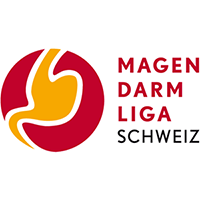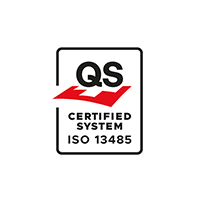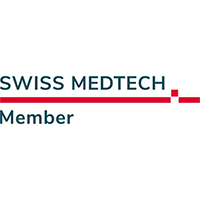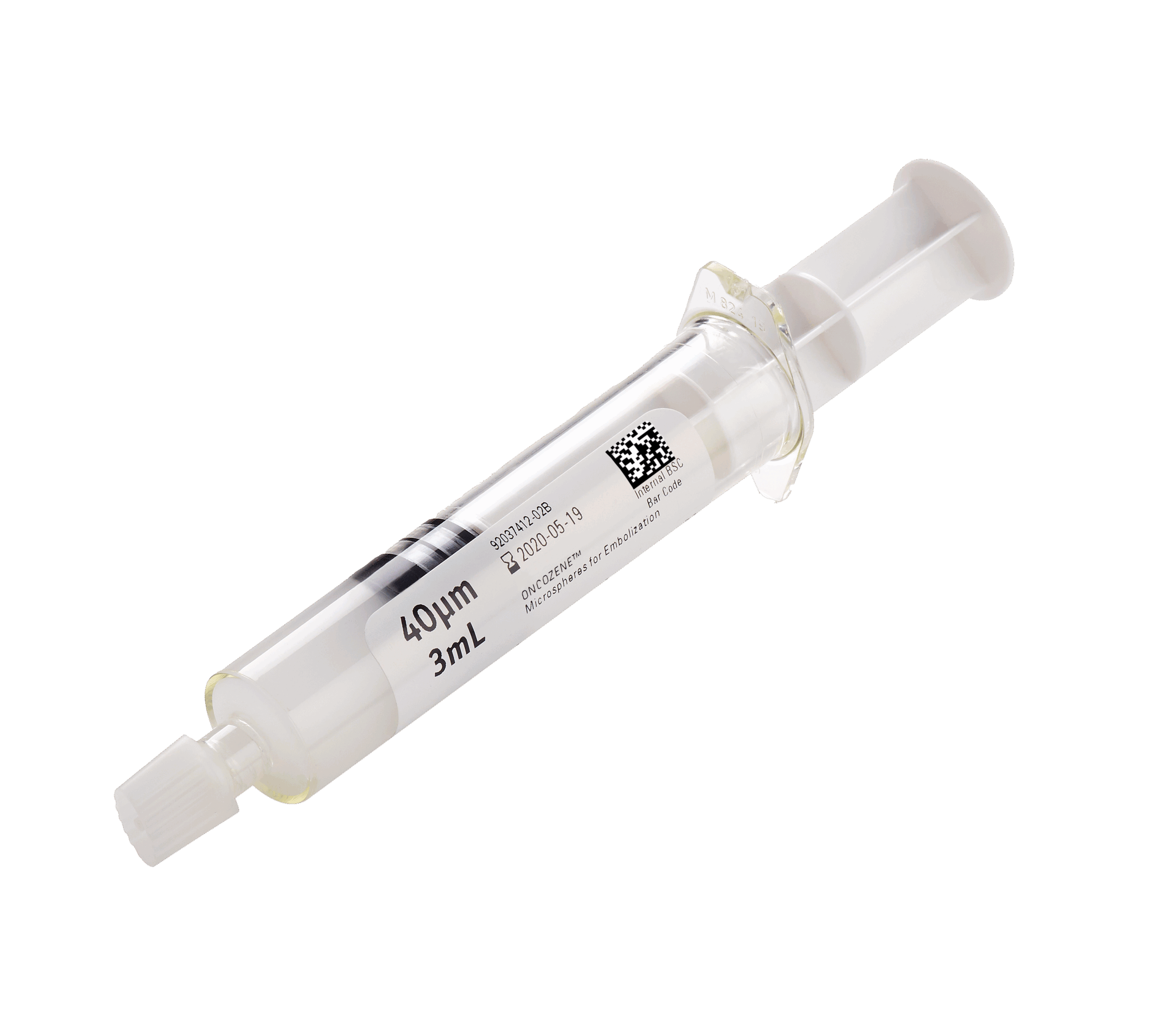Product description
Embozene Tandem® microspheres are designed for drug loading and elution of a local, controlled, sustained drug dose after embolization. They are available in three highly calibrated microsphere sizes (40, 75 and 100 μm) in volumes of 2 and 3 ml of product, and presented in prefilled syringes. Each microsphere, meticulously crafted with ≥95% of the microspheres being within the specified size range (1), guarantees accurate targeting of the specific vasculature.
Size matters: Small and Precise Microspheres Prolonging Lives in Liver Care
Embozene Tandem® microspheres redefine precision with sizes down to 40 μm, ensuring targeted delivery of cytostatic drugs to tumor-feeding arteries.
The smaller particle sizes (40 or 75 μm) contribute to better intratumoral distribution (4), allowing physicians precise control in delivering chemotherapy directly to tumor-feeding arteries, when performing selective TACE (Transarterial chemoembolization) (5, 15). This enhances the concentration of drugs within the tumor leading to high therapy response and disease control rates, while minimizing the risk of local complications, providing a balance of efficacy and safety (6-12, 24).
Indications
Embozene Tandem® Microspheres are indicated for the embolization of blood vessels supplying primary hypervascular tumors or metastases in the liver.
In an examination of liver explants in humans, it was found that just 42% of blocked vessels resided within the tumor when employing 100–300 μm DEBs (drug-eluting beads) (13). This underlines the importance of smaller and precisely calibrated DEBs, which allow a more distal embolization in the tumoral arterial network.
The 40 μm Embozene Tandem® beads allow deep and large volume implantation into the tumor. Histological examinations show the presence of doxorubicin-loaded beads within the interstitium of the tumor, the deepest level achievable (15).
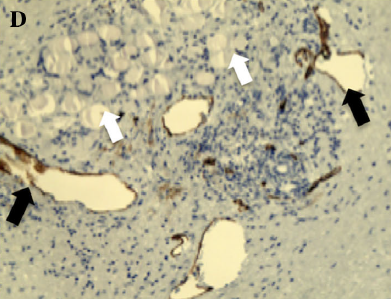
DEB (white arrows), in large numbers, within the interstitium, with adjacent capillaries observed. (CD34 immunostaining of capillaries; original magnification, x20) (15)
Patient-Centric Precision: Strength in Numbers
Due to their tight and uniform size distributions, more microspheres occupy the same volume as compared with a wider size range. For example, a sphere with a diameter of 300 μm occupies 27-times the volume of one 100-μm sphere, thus enabling more 100-μm spheres to occupy the same volume as one 300-μm sphere (13).
Embozene®
| Size | Mean number 2ml |
|---|---|
| 40 μm | 34 Mio. |
| 75 μm | 5.8 Mio. |
| 100 μm | 2.2 Mio. |
DC BeadM1/DC Bead
| Size | Mean number 2ml |
|---|---|
| 70 – 150 μm | 1.3 Mio. |
| 100 – 300 μm | 0.2 Mio. |
| 300 – 500 μm | 38’000 |
Embozene Tandem® Microspheres excel in precise calibration, enabling the delivery of a greater number of small microspheres (≤100 μm) in the same volume. This advantage promotes deeper penetration, higher density, and more predictable coverage within the tumor, enhancing drug exposure and distribution for optimal therapeutic outcomes (13, 15, 16).
Empowering Patient Outcomes with Flexibility
The distinctive solutions, featuring single unit syringes in 2 ml or 3 ml options, set a new standard for flexibility in microsphere counts, while distinguishing it as the sole 3 ml drug-eluting microsphere product on the market.
| Size | Mean number 2 ml | Mean number 3 ml |
|---|---|---|
| 40 μm | 34.0 Mio. | 51 Mio. |
| 75 μm | 5.8 Mio. | 8.7 Mio. |
| 100 μm | 2.2 Mio. | 3.3 Mio. |
Tailored Treatment Approach
The ability to load Embozene Tandem® with various chemotherapeutic agents allows a personalized treatment strategy, addressing each patient’s unique condition and characteristics.
Rapid and Reliable Drug Loading
Embozene Tandem® microspheres achieve over 99% doxorubicin loading within just 1 hour and 30 minutes for the loading of irinotecan, ensuring swift and dependable drug incorporation (13).
Embozene Tandem® microspheres drug-loading capabilities
| Attribute | Doxorubicin | Irinotecan |
|---|---|---|
| Loading amount | 50 mg/ml | 50 mg/ml |
| Loading | 98 ± 2% in 60 min | 98 ± 2% in 30 min |
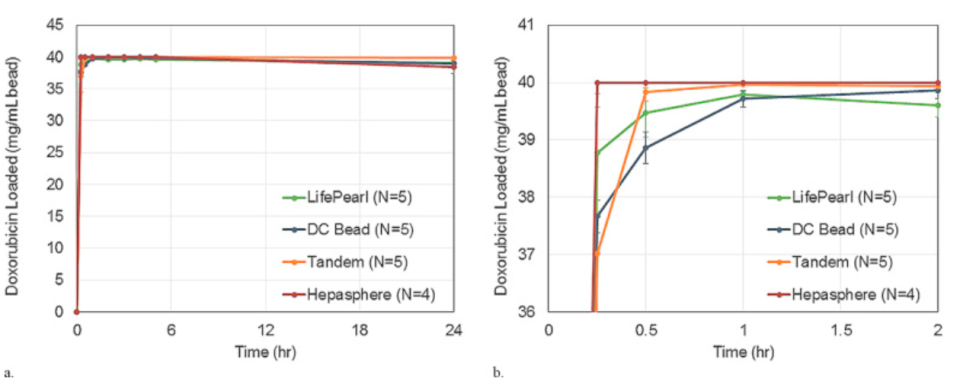
(a) entire duration and (b) reduced time range to illustrate the differences in loading (2).
Microsphere Stability and Consistency
Embozene Tandem® microspheres maintain their distinct shapes and remain separate and spherical, before and after loading with doxorubicin, ensuring stability and consistency (2).
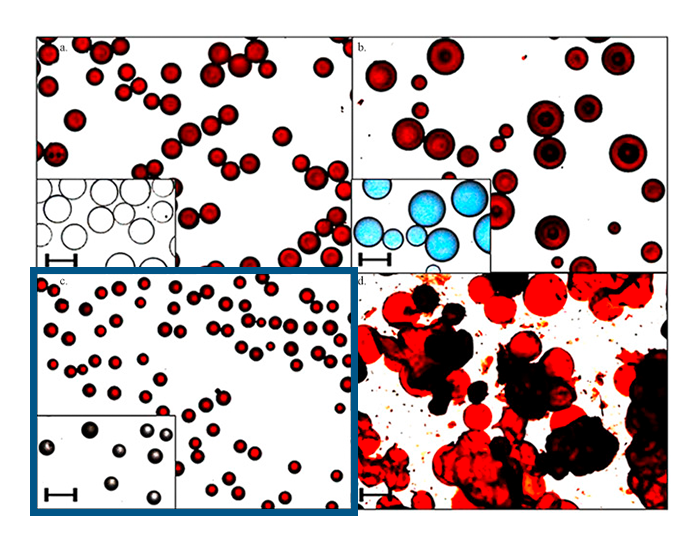
Photomicrographs of doxorubicin-loaded LifePearl (a), DC Bead (b), Tandem (c), and HepaSphere (d) microspheres. Inset images in the lower left corners are photomicrographs of unloaded microspheres. (Scale bars: 200 µm.) (2)
Diameter change comparison after drug loading wirh Doxorubicin
| Microsphere Type | Diameter (µm) Unloaded | Diameter (µm) Doxorubicin-Loaded |
|---|---|---|
| LifePearl | 199 ± 24 | 151 ± 18 |
| DC Bead | 173 ± 53 | 138 ± 46 |
| Embozene Tandem® | 98 ± 15 | 89 ± 15 |
| HepaSphere | NA | 165 ± 28 |
The average diameters of LifePearl, DC Bead, and Tandem microspheres were reduced after loading by 24%, 20%, and 9%, respectively (2).
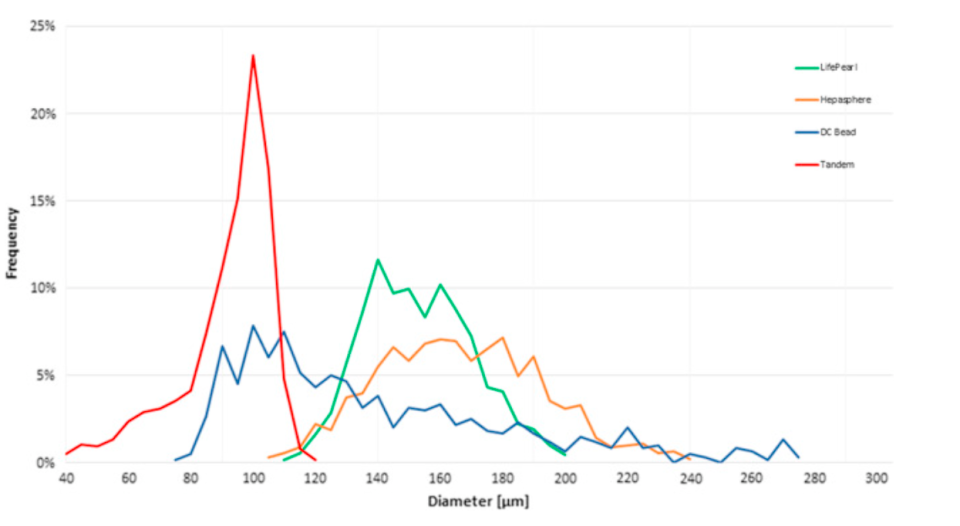
Diameter distribution histograms of doxorubicin-loaded DC Bead (blue), HepaSphere (orange), LifePearl (green), and Embozene Tandem® (red) microspheres (2).
Optimizing Treatment Strategies: Tandem® Microspheres Lead with Enhanced Doxorubicin Release Capacity
Designed to load up to 50 mg/ml of doxorubicin, Embozene Tandem® Microspheres set a new standard in the market, offering healthcare professionals the option to release more doxorubicin, if needed and tolerated by the patient, for improved tumor necrosis. As the exclusive provider of a 3 ml drug-eluting microsphere product, it empowers healthcare professionals to deliver up to 150 mg maximum dose per patient with unparalleled precision and efficacy.
Controlled and sustained drug release with the flexibility to deliver more doxorubicin (1, 17, 18)
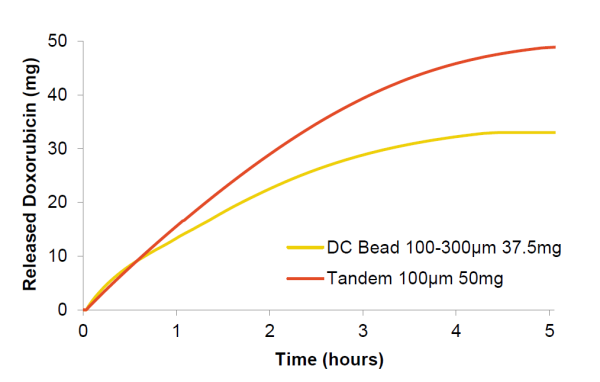
The versatile drug loading possibilities of the Embozene Tandem® microspheres empower physicians to tailor the treatment by choosing and loading the beads with the most suitable chemotherapeutic agent and dose. This personalized approach addresses the unique needs of each patient for a more effective outcome.
Embozene Tandem® at the forefront of TACE treatment
Enhanced Pharmacokinetics for patient comfort
The hydrogel matrix of Embozene Tandem® ensures efficient intratumoral concentrations and a sustained drug release, resulting in improved pharmacokinetic profiles (19). This translates to minimized systemic side effects, enhancing patient comfort and compliance throughout the treatment process and a smoother recovery process with reduced post-procedural discomfort, making it the ideal choice for advancing patient care (12, 13).
The Embozene Tandem® (Oncozene in US) microspheres offer a dual advantage by necessitating a significantly lower doxorubicin dose in comparison to alternative products, thus potentially minimizing drug-related adverse effects (20), while demonstrating comparable or superior short-term radiographic tumor response and survival rates, affirming its efficacy and safety. Furthermore, the lower doxorubicin doses suggest a potential cardioprotective benefit, particularly relevant for patients undergoing multiple TACE procedures (19).
Comparison of Progression-Free Survival and Overall Survival using Embozene Tandem® (19)
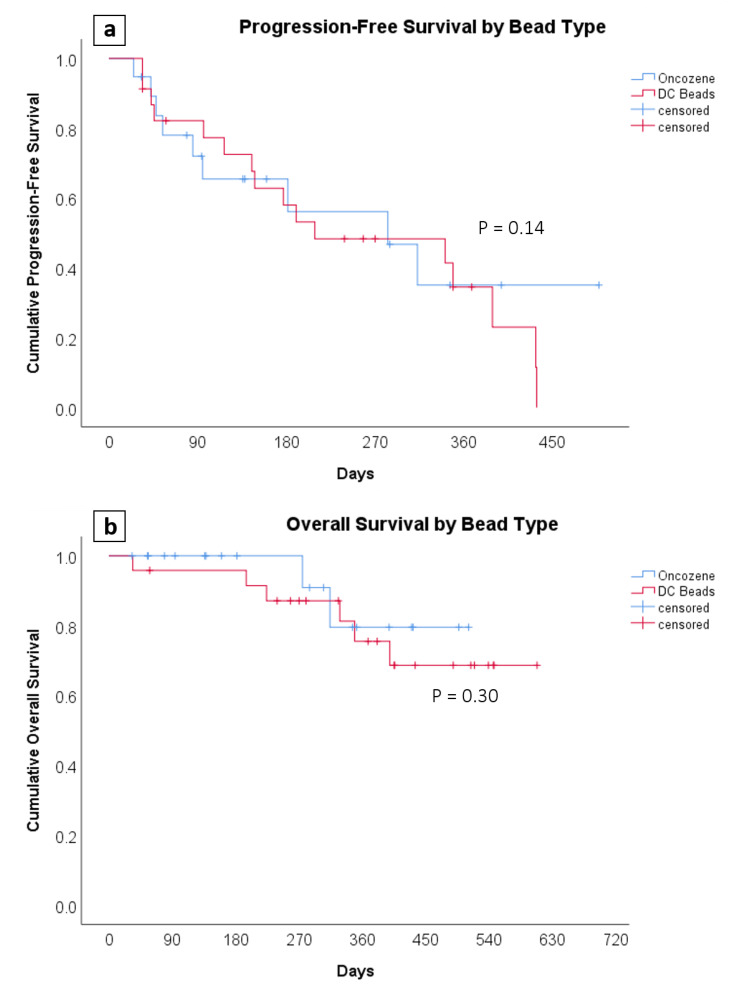
Extended Time in Suspension
Embozene Tandem® microspheres exhibit prolonged time in suspension after loading with doxorubicin, facilitating smoother embolization procedures without frequent interruptions (2).
Comparison of time in suspension after loading with Doxorubicin
| Microsphere Type | Time in Suspension (s) |
|---|---|
| LifePearl | 357 ± 7 |
| DC Bead | 185 ± 11 |
| Embozene Tandem® | 504 ± 12 |
| HepaSphere | 172 ± 20 |
Discover the future of Irinotecan therapy: The benefits of Embozene Tandem® Microspheres
In comparison with alternative products, Embozene Tandem® microspheres exhibit delayed irinotecan elution, with approximately 70% elution at 6 hours. This offers a unique advantage for patients by minimizing systemic side effects throughout the treatment process and minimizing post-procedural discomfort, while resulting in equivalent treatment efficacy (13, 21-23).
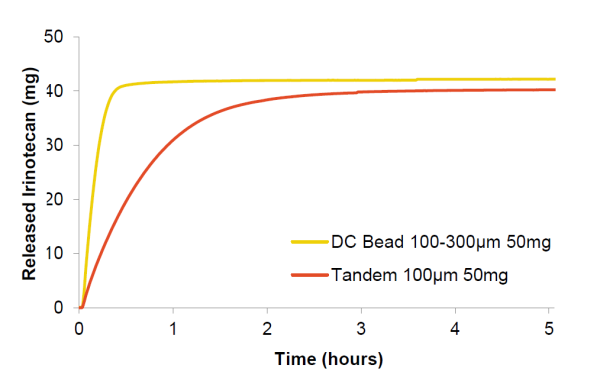
Additionally, after loading with irinotecan, the average diameter was unchanged for Embozene Tandem® microspheres, while the average diameter of alternative products was reduced by 9% and 18% respectively (3).
Diameter change comparison after drug loading with Irinotecan
| Microsphere Type | Diameter (µm) Unloaded | Diameter (µm) Irinotecan-Loaded |
|---|---|---|
| LifePearl | 195 ± 21 | 178 ± 15 |
| DC Bead | 180 ± 58 | 147 ± 44 |
| Embozene Tandem® | 95 ± 16 | 97 ± 15 |
Selected products available directly from our warehouse in Zuchwil – additional variants on request.
All items listed below are in stock at our Zuchwil warehouse and ready for immediate dispatch.
Looking for a different size or variant? No problem – we’ll gladly check availability of other options upon request and provide you with individual delivery information.
Product Specifications and Sizes
| Article number | Size | Size Range | Quantity | Availability* |
|---|---|---|---|---|
| 05-0301-00753-06 | 75 µm | 75 ± 15 | 3 ml | ✅ In stock in Zuchwil |
| 05-0301-01002-06 | 100 µm | 100 ± 25 | 2 ml | ✅ In stock in Zuchwil |
| 05-0301-01003-06 | 100 µm | 100 ± 25 | 3 ml | ✅ In stock in Zuchwil |
*Orders received by 4:00 p.m. on business days are dispatched the same day via A-Post.
Please note: on the day before a public holiday, we can accept orders until 2:00 p.m.
Our consulting team is happy to help you.

Fabio Di Felice
Area Sales Manager for the region Central and South
Certified Medical Technology Consultant shqa
Cantons: BE, SO, TI
+41 79 270 78 51
fdifelice@admedics.com

Anne Rohrbasser
Area Sales Manager for the region West
Certified Medical Technology Consultant
Cantons: FR, GE, JU, NE, VD, VS
+41 79 527 17 63
arohrbasser@admedics.com

Robert Kowalski
Area Sales Manager for the region East
Certified Medical Technology Consultant shqa
Cantons: AI, AR, GL, GR, SG, SH, SZ, TG, UR, ZH, ZG, FL
+41 79 634 59 90
rkowalski@admedics.com

Gina Egli
Area Sales Manager for the region North-Central
Cantons: LU, NW, OW, AG, BL, BS
+41 79 738 60 37
gegli@admedics.com
References
1 Data on file. Varian Medical Systems, Inc. 2020.
2 de Baere, T., Plotkin, S., Yu, R., Sutter, A., Wu, Y., & Cruise, G. M. (2016). An In Vitro Evaluation of Four Types of Drug-Eluting Microspheres Loaded with Doxorubicin. Journal of vascular and interventional radiology : JVIR, 27(9), 1425–1431. https://doi.org/10.1016/j.jvir.2016.05.015
3 Pereira, P. L., Plotkin, S., Yu, R., Sutter, A., Wu, Y., Sommer, C. M., & Cruise, G. M. (2016). An in-vitro evaluation of three types of drug-eluting microspheres loaded with irinotecan. Anti-cancer drugs, 27(9), 873–878. https://doi.org/10.1097/CAD.0000000000000408
4 Bonomo, G., Monfardini, L., Vigna, P.D., Orgera, G., Pedicini, V., & Orsi, F. (2009). Does Microparticle Size Affect Bland Embolization Outcomes of Local Treatment for Liver Malignancies.
5 Stampfl, S., Bellemann, N., Stampfl, U., Sommer, C. M., Thierjung, H., Lopez-Benitez, R., Radeleff, B., Berger, I., & Richter, G. M. (2009). Arterial distribution characteristics of Embozene particles and comparison with other spherical embolic agents in the porcine acute embolization model. Journal of vascular and interventional radiology : JVIR, 20(12), 1597–1607. https://doi.org/10.1016/j.jvir.2009.08.018
6 Yamakado, K., Miyayama, S., Hirota, S., Mizunuma, K., Nakamura, K., Inaba, Y., Maeda, A., Matsuo, K., Nishida, N., Aramaki, T., Anai, H., Koura, S., Oikawa, S., Watanabe, K., Yasumoto, T., Furuichi, K., & Yamaguchi, M. (2012). Hepatic arterial embolization for unresectable hepatocellular carcinomas: do technical factors affect prognosis?. Japanese journal of radiology, 30(7), 560–566. https://doi.org/10.1007/s11604-012-0088-1
7 Martin, R., Irurzun, J., Munchart, J., Trofimov, I., Scupchenko, A., Tatum, C., & Narayanan, G. (2011). Optimal technique and response of doxorubicin beads in hepatocellular cancer: bead size and dose. The Korean journal of hepatology, 17(1), 51–60. https://doi.org/10.3350/kjhep.2011.17.1.51
8 Albrecht, K. C., Aschenbach, R., Diamantis, I., Eckardt, N., & Teichgräber, U. (2021). Response rate and safety in patients with hepatocellular carcinoma treated with transarterial chemoembolization using 40-µm doxorubicin-eluting microspheres. Journal of cancer research and clinical oncology, 147(1), 23–32. https://doi.org/10.1007/s00432-020-03370-z
9 Aal, A. K. A., Moawad, S., Lune, P. V., El Khudari, H., Hanaoka, M. M., Abouldahab, N., Gunn, A. J., White, J., Shoreibah, M., Li, Y., Saddekni, S., & Mahmoud, K. (2019). Survival Outcomes of Very Small Drug-Eluting Beads Used in Chemoembolization of Unresectable Hepatocellular Carcinoma. Journal of vascular and interventional radiology : JVIR, 30(9), 1325–1334.e2. https://doi.org/10.1016/j.jvir.2019.05.006
10 Balli, H., Aksungur, E., Khalatai, B., & Aikimbaev, K. (2019). Super-Selective Transarterial Chemoembolization with Doxorubicin-Loaded Drug-Eluting Beads Sized Below and Above 100 Microns in Hepatocellular Carcinoma: A Comparative Study. Journal of the Belgian Society of Radiology, 103(1), 47. https://doi.org/10.5334/jbsr.1841
11 P. Pallan, M. Wholey, R. Palacios, J. Lutz, A Mendez Castillo, A. Mehta. (2018). 4:21 PM Abstract No. 42 Transarterial chemoembolization with 40-micron drug-eluting beads: a multicenter study, a San Antonio experience. Journal of Vascular and Interventional Radiology: JVIR, 29(4), S22. https://doi.org/10.1016/j.jvir.2018.01.050
12 Greco, G., Cascella, T., Facciorusso, A., Nani, R., Lanocita, R., Morosi, C., Vaiani, M., Calareso, G., Greco, F. G., Ragnanese, A., Bongini, M. A., Marchianò, A. V., Mazzaferro, V., & Spreafico, C. (2017). Transarterial chemoembolization using 40 µm drug eluting beads for hepatocellular carcinoma. World journal of radiology, 9(5), 245–252. https://doi.org/10.4329/wjr.v9.i5.245
13 Delicque, J., Guiu, B., Boulin, M., Schwanz, H., Piron, L., & Cassinotto, C. (2018). Liver chemoembolization of hepatocellular carcinoma using TANDEM® microspheres. Future oncology (London, England), 14(26), 2761–2772. https://doi.org/10.2217/fon-2018-0237
14 Competition information derived from product literature accessed March 2023
15 She, H. L., Burgmans, M. C., Coenraadm, M., & Saraqueta, A. F. (2016). In Vivo Proof of Superselective Transarterial Chemoembolization with 40-μm Drug-Eluting Beads in a Patient with Hepatocellular Carcinoma. Cardiovascular and interventional radiology, 39(1), 137–140. https://doi.org/10.1007/s00270-015-1154-8
16 Heithaus, R., Cura, M., Waller, A., Hise, J., Daoud, Y., Lee, M. (2017). Tumor necrosis after selective transarterial chemoembolization for hepatocellular carcinoma, the role of bead concentration: Journal of vascular and interventional radiology : JVIR, 28(2), S124. https://doi.org/10.1016/j.jvir.2016.12.899
17 Tandem Directions for Use
18 Competition information derived from product literature accessed March 2020
19 Hung, M. L., Jiang, J., Trieu, H., Hao, F., Eghbalieh, N., Ding, P. X., & Lee, E. W. (2021). Transarterial Chemoembolization of Hepatocellular Carcinoma with Oncozene Microspheres: An Initial, Short-Term Clinical Experience-A Retrospective, Matched, Comparison Study. Life (Basel, Switzerland), 11(7), 600. https://doi.org/10.3390/life11070600
20 Lee, S. H., Lin, C. Y., Hsu, Y. C., Liu, Y. S., Chuang, M. T., & Ou, M. C. (2020). Comparison of the Efficacy of Two Microsphere Embolic Agents for Transcatheter Arterial Chemoembolization in Hepatocellular Carcinoma Patients. Cancer research and treatment, 52(1), 24–30. https://doi.org/10.4143/crt.2019.018
21 G. Laidlaw, D. Wang, D. Sze, G. Hwang, J. Louie. (2017). Clinical toxicity of irinotecan-eluting microsphere TACE for colorectal cancer hepatic metastases: oncozene versus LC bead: Journal of vascular and interventional radiology : JVIR, 28(2), S159.
22 Gnutzmann, D. M., Mechel, J., Schmitz, A., Köhler, K., Krone, D., Bellemann, N., Gockner, T. L., Mokry, T., Kortes, N., Sommer, C. M., Kauczor, H. U., Radeleff, B. A., & Stampfl, U. (2015). Evaluation of the plasmatic and parenchymal elution kinetics of two different irinotecan-loaded drug-eluting embolics in a pig model. Journal of vascular and interventional radiology : JVIR, 26(5), 746–754. https://doi.org/10.1016/j.jvir.2014.12.016
23 Tanaka, T., Nishiofuku, H., Hukuoka, Y., Sato, T., Masada, T., Takano, M., Gilbert, C. W., Obayashi, C., & Kichikawa, K. (2014). Pharmacokinetics and antitumor efficacy of chemoembolization using 40 µm irinotecan-loaded microspheres in a rabbit liver tumor model. Journal of vascular and interventional radiology : JVIR, 25(7), 1037–1044.e2. https://doi.org/10.1016/j.jvir.2014.04.005
24 A. Kamel Abdel Aal, S. Moawad, B. Jackson, M. Hanaoka, C. Baalmann, N. Ertel, K. Pettibon, A. Harris, A. Patel, Z. Lambertsen, G. Newman, S. Saddekni. (2017). Tumor response and survival outcomes of very small drug-eluting beads used in trans-arterial chemoembolization for unresectable hepatocellular carcinoma: Journal of vascular and interventional radiology : JVIR 28(2), S124-125.
https://doi.org/10.1016/j.jvir.2016.12.900
Certificates and memberships
